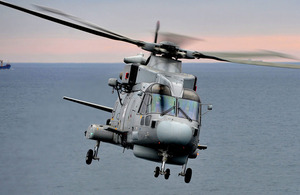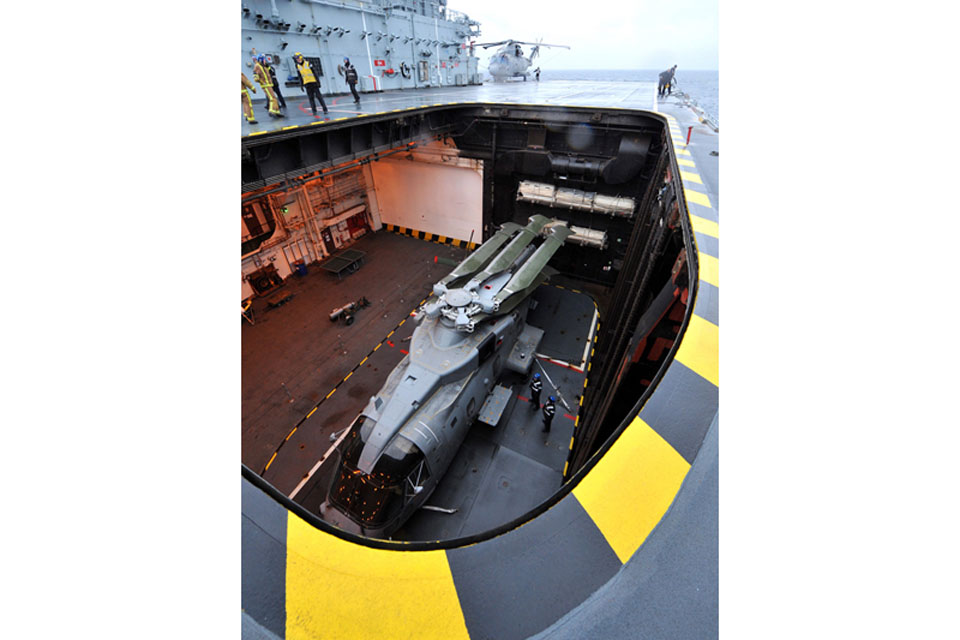Last training on the Navy's Merlin Mk1 helicopter
The final batch of Merlin aircrew are now completing years of arduous training off the Cornish coast on the Merlin Mk1 helicopter before the Fleet Air Arm gets the next-generation version of the helicopter.

A 824 Naval Air Squadron Merlin Mk1 helicopter [Picture: LA(Phot) Dave Sterratt, Crown Copyright/MOD 2012]
Eighteen trainee pilots, observers and aircrewmen from 824 Naval Air Squadron at Royal Naval Air Station Culdrose are spending five weeks flying on, off and around aviation training ship Royal Fleet Auxiliary vessel Argus. They are the last crews to train on the Mk1 variant of the aircraft before the Merlin Mk2 joins the Fleet Air Arm later this year.
The trainees have completed between two and four years of training and instruction both on simulators and on the genuine article.
But their stint on the 28,000-tonne training ship - which doubles as the Navy’s casualty treatment vessel in times of war - is their first taste of operating the Merlin, which is the mainstay of the Royal Navy’s anti-submarine and counter-piracy operations around the world.
Aboard Argus, the trainees go from the basics of landing on and taking off from a flight deck at sea to practising search and rescue drills, then on to tactical missions such as hunting submarines or surface ships.
Student pilot Sub-Lieutenant Will Legge said:
You learn so much more in the real world than you do on a simulation. The real world provides 100 times more variation, things that you can never plan.
And if things go wrong, you cannot just press ‘reset’.
Completing the first deck landing is a milestone. You are pretty nervous beforehand, because the deck looks tiny.

A Merlin Mk1 helicopter on the aircraft lift of RFA Argus [Picture: LA(Phot) Dave Sterratt, Crown Copyright/MOD 2012]
Sea Flight Commander and senior 824 Naval Air Squadron instructor aboard RFA Argus, Lieutenant Commander Mike Currie, said of the five-week training spell:
This is where we put into practice all that has been taught previously - it is almost the final hurdle.
You have to have a certain temperament to succeed, a certain Fleet Air Arm ethos, but the pilots, observers, aircrewmen, they are all individuals. There’s no one trait and we’re certainly not trying to produce carbon copies of ourselves.
Commander Gavin Richardson, 824 Naval Air Squadron’s Commanding Officer, added:
The embarked period is what the squadron team effort works toward.
It is the crowning glory of a long and arduous road for our students which provides the opportunity to show the investment was worthwhile and that they have metamorphosed into naval aviators, able to operate and fly from that most demanding environment - the sea.
If the students come through the training, they will earn their wings in June and go on to join one of three front line Merlin squadrons based at Culdrose.
In doing so, they will be the last of scores of Merlin crews to pass through the squadron and the impressive simulator and training complex at the air station on the Lizard Peninsula since the late 1990s.
Merlin was originally introduced as a submarine hunter to replace the venerable Sea King. It has since grown into a general purpose helicopter capable of interdicting pirates and drug runners, saving the lives of stricken mariners, and delivering stores and people, as well as fulfilling its original anti-submarine mission.
The first next-generation naval Merlin, the Mk2, arrives in Cornwall this summer. Although outwardly the helicopter is almost identical, inside the cockpit and the command consoles are entirely new:
There is no comparison with other aircraft out there,” said Lieutenant Commander Currie, who has 1,800 Merlin flying hours under his belt.
It’s pretty awesome when it comes to what it can do - especially the variety.
Things have moved on since the Mk1. It has served us well - and still serves us well - but it’s time to move on.
824 Naval Air Squadron will learn the ins and outs of the new helicopters first before the rest of the Merlin community gets to grip with them and it begins front line deployments.